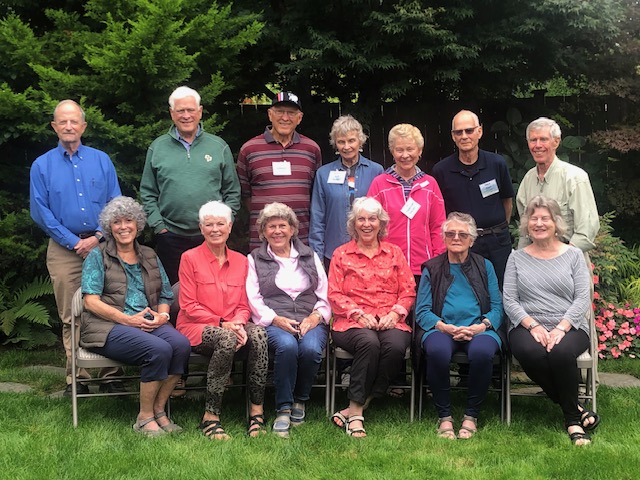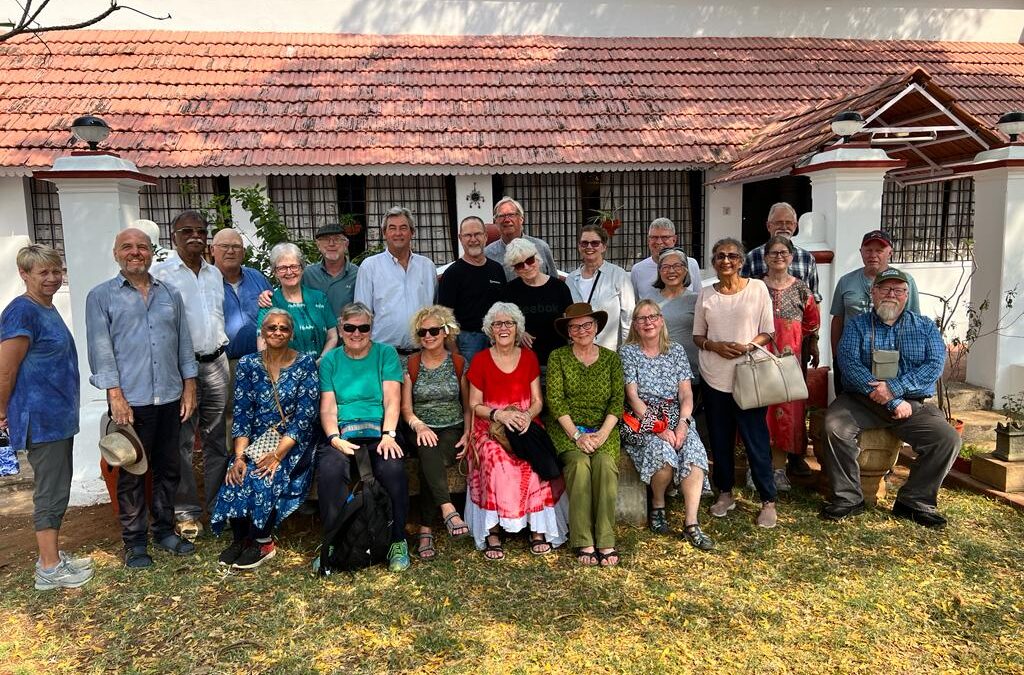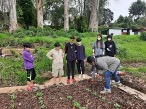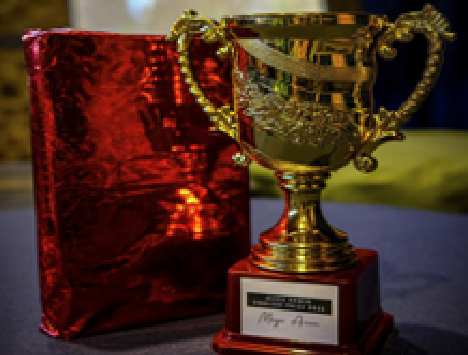
by kfi | Oct 20, 2023 | Announcements, North America Alumni Events |
Kodai kids had a really lovely reunion in Edmonds Wa this September 10 -14. It was an eclectic group, with a nice assortment of “other years” joining the mainly ‘59 and ‘61 ers who organized it. SaraAnn Lockwood and Virginia Herlong we’re the chiefs, assisted by a number of locals who provided great support.
Our agenda was Different from traditional reunions in that we were at a hotel rather than a retreat center and our days were separated by the choices of activities offered. One group had a beautiful tour of Whidbey Island and others puttered around the marina and into the quaint town of Edmonds.
Both evenings were well planned. A KODAI Alum staffer showed slides and spoke to us of the impact the alumni are having on the school development. The second night, David Rugh from Woodstock ‘50’s era spoke of his research on whales. He joined in our Whale Cruise the next day, when we were treated to lengthy sightings of three wonderful species of Washingtonian whales .
Special for the ‘61 attendees was the fact that we came together 24 hrs earlier than others and were able to have a particularly meaningful time of personal sharing Sunday night. We especially delighted in several new attendees. The following day we gathered for a collectively created feast at Steve and Donnas beautiful home in Mukilteo.
Of all the reunions many of us have attended, this one reportedly was more intimate and satisfying for the connections, old and new, that became possible by the setting, the program and the participants who chose to come.
Shabash to all!

by kfi | Oct 19, 2023 | North America Alumni Events |
The KIS Class of 1973 50th Reunion, An Outsider/Insider View – Bonni-Belle Pickard
Disclaimer! I am not a legitimate member of the KIS Class of 1973 as I only arrived in Kodai in 1978. But the person who brought me to Kodai, my husband, Alfred Pickard, had been a member of the class since 1961 and had been regaling me with Kodai stories for the three years that I had known him. I had decided I either had to go experience Kodai for myself or get rid of him. We moved to Kodai in 1978 to be on the teaching staff for two years, and we stayed for the next 20 years, during which time I got to know many members of the Class of 1973, several of whom were also KIS staff for longer or shorter times. One of those members, Priscilla Dhanapal Mohl, remains one of my closest friends to this day; we raised our children together in Kodai and worked together for many years with Bethania Home for Abandoned Children and the Kodai School Chapel and in the Music Dept. Together we navigated eye operations, a broken leg, family funerals, choir practice and Sunday School classes, committee meetings, long road journeys on the plains, legal and guardianship challenges, drought, floods, cyclones, silverfish, bundhs, as well as our children’s first days at school and their various teenage disciplinary challenges. We ‘survived’, which often seemed to be a Kodai mantra.
The run-up to the Class of 73’s 50th anniversary reunion in Kodai first came to my attention through incessant pinging of my husband’s phone in the evenings at our home in Maidstone, Kent, during COVID. After a ping, Alfred would lift his eyebrow and excitedly tell me what was going on with Johnny and Louise or Pandy or Pris or Vince or Henry or Bruce or John via the Whatsapp messages. Indeed, I knew nearly all of them and had stayed in most of their homes (or they in ours) over the past 45 years. He talked of them as if they were his siblings – their challenges, their achievements, their annoying bits – and I began to understand in a new way that they had indeed been his ‘siblings’ growing up for over 10 years together in boarding school, far away from home.
As plans for ‘the 50th’ grew closer, I got added to the Whatsapp group, and my own phone began pinging incessantly. We bought our air tickets and got accommodation and travel and what-kind-of- currencies-would-be-needed within India sorted out by those who lived locally. I knew Manju Ninan (now Alumni Director) from the years that she and her family lived next door to us in Kodai and had been close friends and classmate with Priscilla and our daughters. In typical Kodai fashion, the generations melded together when any help was needed on anything.
I knew Alfred was excited to see ‘his class’ again, but there was also some trepidation. Those formative years of his still contained potent memories – who-did-what-to-or-with-who-and-when-and-where — and why. He played over in his mind whether the old cliques would be intact, whether he would fit in, sometimes wondering if the trip would be a huge waste of time and money. But we went.
As soon as we arrived at Bengalaru Airport (still Bangalore, in our minds!), Alfred’s Indian language and bartering skills went into overdrive. Pandy had sent a taxi to drive us to his coffee plantation in the hills of Yercaud, several hours away, where the first part of the reunion would take place. Alfred and the taxi driver managed to find each other in the midday chaos of the Airport carpark, and having piled the luggage in, soon we were inching our way through the endless snarls of city traffic. After a few hours, we got to the ‘open’ highway, with its frequent police barriers blocking off sections of the road in a desperate attempt to calm the speed of the traffic. It was at one of these that we soon found ourselves in the middle of a several-car pileup. We were unhurt, but the taxi was no longer driveable. We laid low in the backseat, thankful that the tinted windows hid our white faces, while the driver got involved in the negotiations. Soon another taxi arrived to speed us off to our destination, thanks to the driver and Pandy’s connections. We arrived at the coffee plantation late in the evening, but in time for a delicious vegetarian biryani shared with nearly all the folks that I, too, had come to think of as ‘siblings-in-law.’
The next week was a blur of activities and meals and excitement and laughter – and conversation. As an ‘in-law’, I knew to respect the intimacy of the long-established links and relationships within the ‘siblings’, but they were also gracious to include me – and a few others like me who had come as spouses or actual family members – in conversation as we sat at meals or around the campfire or walked or rode around the coffee plantation. I began to realise that virtually all of them had brought their own hopes and fears and anxieties to the reunion. What about that night in the dorm or that first date or what she said in so-in-so’s class or what happened in the Budge or that time I was so homesick…? Gradually the memories of 50 (or 60!) years became subtly reshaped and re-interpreted. Some of the most painful memories retained were remembered in quite different ways by others – or not remembered at all. Had s/he actually said that, or was that just what got passed on in the gossip? And if s/he had indeed said it, was it really a case of teenage posturing rather than an indictment of my own inadequacy – or my feelings of inadequacy? Meeting each other as adults – kind, considerate, intelligent, and much wiser persons – began to soften and release the sharp edges of painful memories from uncertain teenage years.
The others from the Reunion can tell more stories about what the group actually did in that week of late February and early March 2023: the time at Pandy’s plantation (actually named after his wife, Gowri); the day-long bus journey to Kodai; the intense few days in Kodai touring the school, the Environmental Centre, the bazaar, Bob Granner’s house, the restaurants, the Alumni Banquet, the church service, and, of course, Field Day! We viewed one of the award-winning films that John and Louise Riber had made about teenage pregnancy in Zimbabwe and heard an excellent speech from Bruce Campbell about his work with Public Health for the UN in many parts of the world. We recognised that many from the class had gone on to work in mental health or church ministry or law or engineering or teaching or travel, some rising to quite high position, others remaining more low-key. Somehow all had remained faithful – or returned! — to principles learned in Kodai of respect and fairness and concern for the well-being of all, especially for those coming from or dealing with challenging socio/economic circumstances.
As we chatted with those currently at the school, we were pleased to recognise many of those same values of respect and fairness and concern for well-being, even as we heard whispered accounts of those who, inevitably, were struggling, including current students wrestling with depression and anxiety… What legacy might we leave them?
A very important event took place on the last day before some began to leave to go back to the various parts of the world they now call ‘home’. It followed immediately after the church service that the class members had all attended, one in which the class sang ‘Let there be peace on earth’ as they had at their Baccalaureate Service 50 years before. The group then piled into the school vans for a short tree-planting event on the Ganga Compound. The school’s ambitious target of re-planting thousands of shola trees had been announced, and the class wanted to plant a few trees for class members who had died since their time in Kodai.
The ecological aspect was an important draw on its own, but the actual taking time to dig in the Kodai clay, to flex leg muscles more accustomed to flat pavements than to dusty hillslopes, and, finally, to remember and speak words about those departed was even more powerful.
In short, quiet, reflective words, class members recalled the lives of three of their own who had indeed died. Words spoken out loud slowly but surely released a new understanding of the demons each of those departed – as well as those present – had fought with. For the first time perhaps, there was a realisation that each of those departed had, whether intentionally or not, taken their own lives because of the enormous difficulty of reconciling themselves and their situations to that of the outside world. Each had somehow felt that the anxieties within themselves were so unique that no one else could understand or accept them as they were.
As muscles strained to loosen the packed clay of the Kodai hillside, emotions and past memories – and prayers – were released. The class said its good-byes to those who had succumbed to the struggles. Using one’s bare hands to cover the roots of the saplings with Kodai dirt, tamping down the dust with one’s foot, flooding the indentation in the soil with the shola water in the watering can, stepping back to get the view of what is beyond: these were actions that helped the class reflect again on their own past and look to the future. Some painful memories, having been exposed to the light of day, needed to be re-buried with forgiveness. Other memories needed to be nourished for the good they had produced. And now a new generation needed nourishing as well – towards an abundant and peaceful future for the timeless Kodai hills, all those who live there now, and all who will come after.
Thank you, Class of ’73, and thank you, Kodai, for allowing me to be part of the family and part of the growing.
–Bonni-Belle Pickard

by kfi | Oct 4, 2023 | Projects - current |
In March 2022, the KIS Center for Environment and Humanity submitted a grant proposal to Kodai Friends International to support the establishment of a Seed Bank, Nursery, and Food Forest on the CEH campus (former Swedish school) over the course of 3 years. The objectives of this project are:
- to raise awareness about the threatened biodiversity of the Palani Hills
- to provide experiential learning opportunities for KIS, local, and international visiting students on biodiversity conservation and its intersection with land use and modern agriculture
- and, to practice sustainable land management, regenerative agriculture, and biodiversity conservation within our campus.
Summary of Activities:
Thanks to funding from Kodai Friends International for Year 1 of the project, CEH gathered environmental expertise to develop a regenerative agriculture based landscape design for the 2-acre property. While the landscape design was in progress, CEH began cultivation on a small area of the campus to experiment on sustainable farming techniques with students and local farmers. CEH also started a small Shola Nursery for saplings to be planted within the CEH and other KIS campuses. Finally, CEH integrated this project and the concept of Regenerative Agriculture into the KIS Ecoclub for students grade 9-12. This project served as a platform for KIS students to understand agriculture practices in Kodaikanal through field trips and interactions with farmers in villages such as Poombarai, Prakashapuram, Pallangi-Kombai, and Vilpatti. Students also worked to develop the cultivation zone on the CEH campus, where they planted legumes, vegetables, herbs, and flowers. It was a challenge to use only organic and regenerative agriculture principles on our land, but this exercise helped students internalize the difficulties that farmers face in producing food at a large scale. Through the KIS Ecoclub and this Food Forest project at CEH, we encourage all students to think about the future agriculture, and how it can be improved by making food systems more efficient, inclusive, and resilient, while ensuring a sustainable natural resource base.
Expansion of Project in 2023-24: Funding for Year 1 of the Food Forest Project Proposal submitted in March 2022 was crucial in boosting CEH’s activities and direction toward sustainable land management and regenerative agriculture. Throughout our activities in Year 1, we learned that the project has scope to be much larger than a food forest, Shola nursery, and seed bank. We seek to expand the project to the entire campus to offer an immersive learning experience on the intersection between agriculture and biodiversity. The outdoor space will be divided into different zones according to regenerative agriculture objectives, with a trail connecting various zones to facilitate campus tours. The journey will highlight sustainable farming, ecosystem services, climate resilience, carbon sequestration, soil and water management, and self-sustenance. CEH now has a detailed design for the entire property to help visitors understand concepts of a food forest, sustainable land use, and backyard biodiversity conservation within the context of the Palani Hills. Local residents, school students in Kodaikanal and abroad, and tourists will leave CEH with the knowledge, tools, and inspiration to implement principles of regenerative agriculture wherever they go.
Spending Summary:
In Year 1, CEH focused on preparing the land, collecting all the basic tools and equipment required to set up a food forest, and gathered information from environmental experts to plan and design the 2-acre property. 62% of the Year 1 funds were used toward environmental expertise to put together a detailed landscaping plan and of the CEH outdoor space. Due to unmet expectations of a consultant hired in June 2022, the project was recommissioned to environmental experts in permaculture and wild-scaping design – this resulted in an additional 1 Lakh Rupees spent on environmental expertise. Maintenance of the pear orchard, vegetable beds, nursery, and shola forest zone require consistent operational labor – 29% of Year 1 funds were used for landscaping and seasonal operations. Finally, CEH did not build a greenhouse in Year 1 as planned. Instead, we used the greenhouse as a hands-on learning opportunity for students to construct one on their own using bamboo. This bamboo greenhouse will be used for ornamental plants. CEH will build a larger greenhouse for summer crops such as cucumber, tomatoes, chilies, bell peppers, and eggplant in Year 2.
Year 1 Spending Categories and Balance:
| Item |
Amount Budgeted (INR) |
Amount
Debited (INR) |
Balance
(INR) |
| Maintenance and Operations |
438,000 |
218,536 |
219,464 |
| Tools and Input Materials |
385,000 |
68,867 |
316,133 |
| Environmental Expertise |
360,000 |
461,000 |
-101,000 |
| Total (INR) |
1,183,000 |
748,403 |
434,597 |
| Total (USD) |
15,270 |
9,132 |
5,303 |








